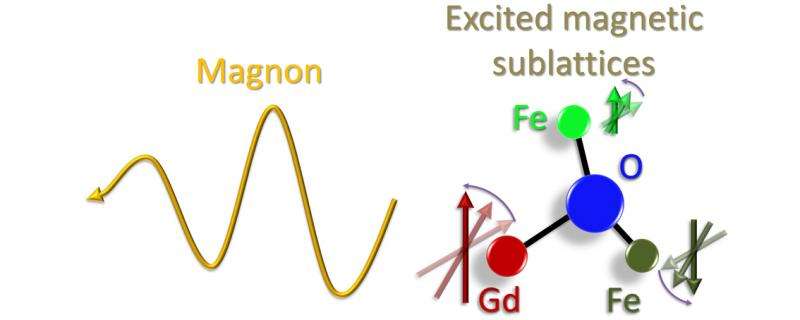Researchers present new findings on magnetic spin waves

An international team of researchers gained new insights into magnetic spin waves. Spin waves can evolve in electrically non-conducting materials given a specific temperature gradient and then be converted into electrical energy in an adjacent metallic layer. Thus, thermal energy can be converted into electrical energy. This recently discovered principle allows to think of new ways to recover waste heat and can improve a great variety of processes to be more energy-efficient and environmentally sustainable. The joint research project involves researchers of Johannes Gutenberg University Mainz (JGU), the Walther Meißner Institute for Low Temperature Research in Garching, Tohoku University in Japan, and Delft University of Technology in the Netherlands. The resulting research paper was published in the scientific journal Nature Communications.
Spin waves, or magnons, are fundamental excitations in magnetic materials which transport energy and angular momentum. The latter allows to make use of them for the transmission of information within magnetic solids. Since their existence is bound to that of magnetic solids, they are challenging to measure. This circumstance led to quite a number of difficulties with respect to the proof of fundamental theories about the properties of magnetic materials. In a joined project, the researchers involved were able to show that even in complex systems consisting of many different magnetic atoms, magnons can be thermally excited by making use of the recently understood spin Seebeck effect. These results furthermore show that the spin Seebeck effect can be employed to probe fundamental properties of such systems in a simple way and thus to deduce the complex interplay of the constituents.
Spin waves out of waste heat
The spin Seebeck effect represents a so-called spin-thermoelectric effect, which enables the conversion of thermal energy into electrical energy. Contrary to conventional thermoelectric effects, it also enables the recovery of heat energy in magnetic insulators in combination with a thin metallic layer. Researchers at Mainz University have recently been able to demonstrate that the origin of the spin Seebeck effect can be understood as thermally excited spin waves within the magnetic solid. These thermal spin waves present a so far unexploited way for the energy recovery of waste heat.
Following this discovery, the researchers started investigations of more complex materials, so called ferrimagnets. In contrast to simple ferromagnetic materials, ferrimagnets possess a non-trivial temperature dependence of the magnetization, resulting of a complex interplay of its different magnetic sublattices. By making use of temperature dependent spin Seebeck measurements of ferrimagnetic materials, it was possible to deduce characteristic and thus unique signal features. These features can be traced back to the magnonic origin of the effect and therefore allow to gain a new idea of thermal magnons and their distribution.
"Seeing the complicated signal behavior for the first time, I did not think that one could learn so much about the complex and intrinsic interaction within the materials. All this has only been possible due to the excellent collaboration with our national and international colleagues", said Andreas Kehlberger, who just recently finished his PhD in the research group of Professor Mathias Kläui, supported by a stipend of the Graduate School of Excellence "Materials Science in Mainz" (MAINZ) at Johannes Gutenberg University Mainz.
More information: Stephan Geprägs et al. Origin of the spin Seebeck effect in compensated ferrimagnets, Nature Communications (2016). DOI: 10.1038/ncomms10452
Journal information: Nature Communications
Provided by Universitaet Mainz


















